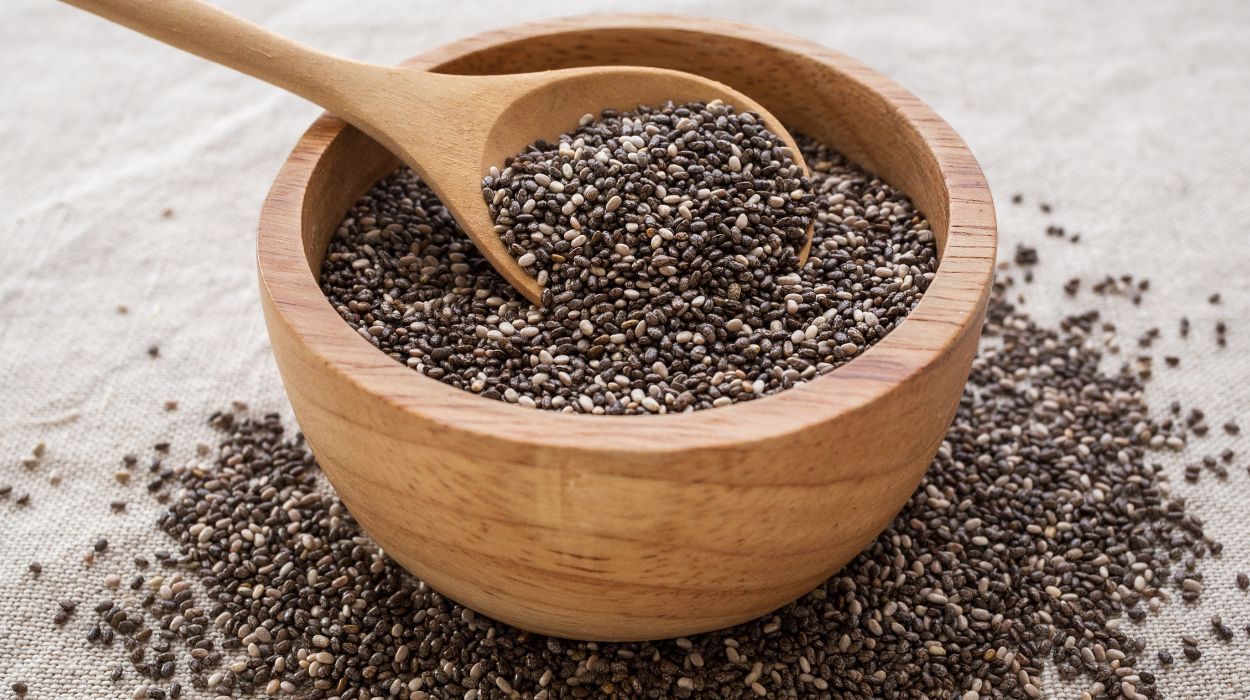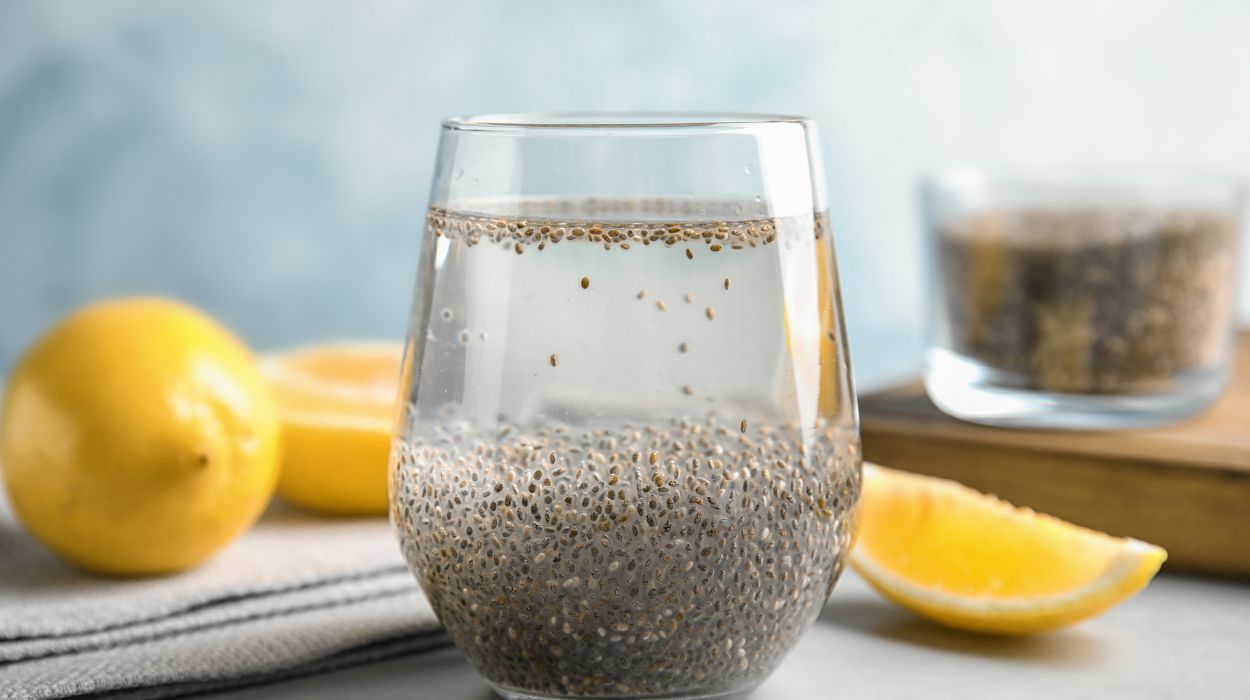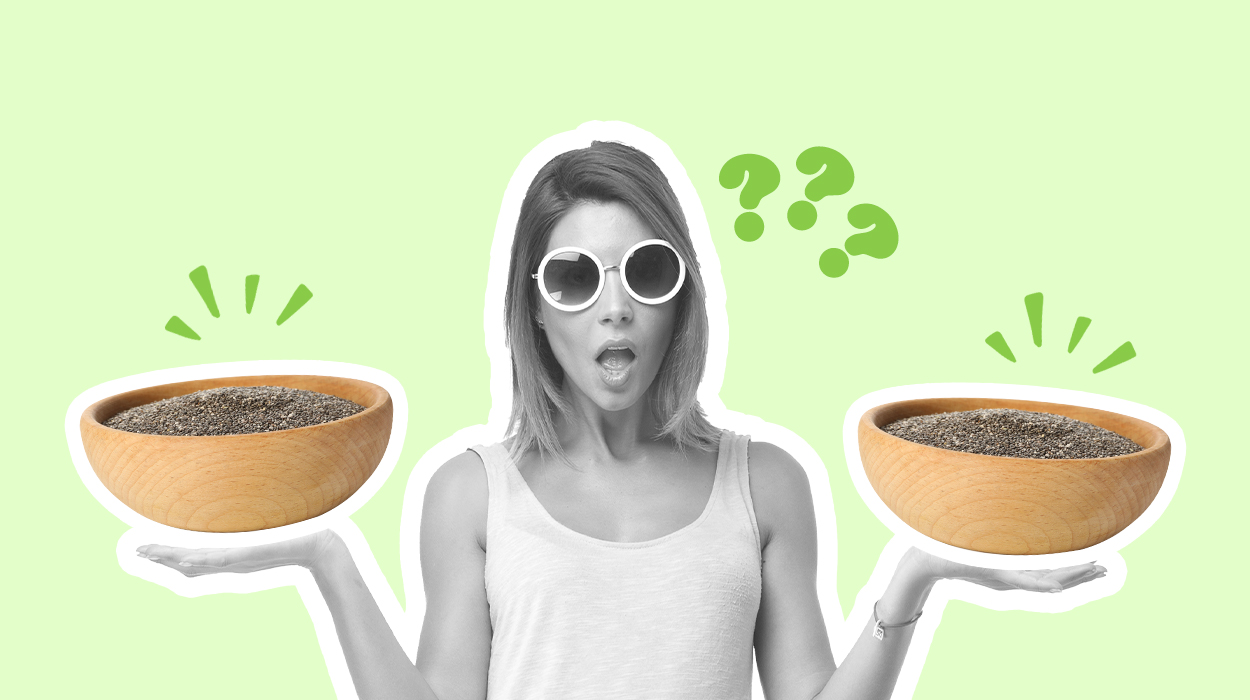Chia seeds are miniature health gems that offer many benefits in each tiny package.
As you read on, we will unravel the impressive health benefits of chia seeds, showcasing why they are a valuable addition to your diet. From providing a well-rounded mix of essential nutrients to promoting heart health and boosting digestion, these seeds have significant health benefits for everyone.
Furthermore, figuring out how to eat chia seeds can be as simple or gourmet as you’d like. They can be enjoyed raw, soaked in water, added to your favorite smoothie, or baked into a bread loaf. When soaked, they expand and create a gel-like consistency that lends well to recipes like chia seed pudding.
Dive in with us as we explore the benefits of chia seed.
Chia Seeds Nutrition
An ounce (28 grams) of chia seeds carries 138 calories.[1] Breaking it down by weight, dry chia seeds comprise 6% water, 46% carbohydrates (where a substantial 83% is fiber), 34% fat, and 19% protein.
When considering a larger portion, the nutritional breakdown for 3.5 ounces (100 grams) of chia seeds is as follows:
- Calories: 486
- Water: 6%
- Fiber: 34.4 grams
- Fat: 30.7 grams
- Protein: 16.5 grams
- Carbs: 42.1 grams
- Sugar: 0 grams
- Saturated fat: 3.33 grams
- Trans fat: 0.14 grams
- Monounsaturated fat: 2.31 grams
- Polyunsaturated fat: 23.67 grams
- Omega-3: 17.83 grams
- Omega-6: 5.84 grams
Chia Seeds Benefits
Stimulate Weight Loss
Chia seeds’ remarkable high-fiber content makes them a compelling choice for those striving to lose weight. Consuming a standard quantity of chia seeds daily.
Ideally, consuming between 25 and 38 grams of chia seed every day could be instrumental in helping you trim down your weight. An added benefit is the potential reduction of abdominal fat, which these seeds have been reported to facilitate.
Prevent Constipation
Whole chia seeds are notably high in fiber, particularly insoluble fiber, which undergoes a gel-like transformation upon encountering water. This reaction contributes to the bulk of your stool, thus enhancing bowel regularity and offering a solution to constipation issues. Research further expands[2] on the role of fiber in promoting optimal digestive health.
Boost Omega-3
Omega-3 fatty acids are vital for our brain and body function, and chia seeds offer a rich source. In addition, recent studies[3] indicate that consuming chia seeds can enhance the blood concentration of Omega-3 alpha-linolenic acid (ALA) and Eicosapentaenoic acid (EPA).
Remarkably, increases of up to 138% for ALA and 39% for EPA have been reported. However, ALA requires conversion into active forms, such as EPA, before the body can utilize it.
Regulate Blood Sugar
Chia seeds also possess the ability to help maintain balanced blood sugar levels, a factor critical to general well-being. In addition, experimental research on animals has suggested that chia seeds can potentially decrease insulin resistance and augment the control of blood sugar levels.[4]
Effective management of blood sugar is pivotal in reducing the danger of metabolic syndrome, type 2 diabetes, and cardiovascular disease.
Additionally, evidence from human studies[5] suggests that integrating chia seeds with staple foods such as bread can lead to a milder blood sugar reaction compared to consuming conventional bread.
Reduce Blood Pressure
High blood pressure is a known risk factor for numerous chronic diseases, particularly heart disease. Chia seeds and chia flour[6] have been observed to lower blood pressure in individuals with elevated levels.
This suggests that including chia seeds in our diet could be instrumental in maintaining healthier blood pressure levels.
High Fiber Intake
Chia seeds boast a remarkable attribute- their abundant fiber content.[7] Just a single ounce (28 grams) of chia seeds provides nearly 9.75 grams of fiber, meeting a significant portion of the daily fiber intake (25-30 grams of fiber per day) recommended for both males and females.
Incorporating a fiber-rich diet has been linked to enhanced gastrointestinal health and a lower likelihood of several health disorders.
Furthermore, owing to their extraordinary ability to absorb water, chia seeds increase the bulk of your food as it progresses through your digestive system. This results in heightened feelings of fullness, potentially curbing your overall food consumption.
What Are Chia Seeds?

Chia seeds gained widespread recognition from the commercial product ‘Chia Pets,’ where the chia seeds sprout into a lush green cover on various decorative figurines. However, in recent years, their health benefits have also earned them the title of ‘superfood.’
A recent study found that consuming chia seeds in water could amplify their health benefits, showing a 40% increase in hydration[8] compared to consuming them dry.
Where Do Chia Seeds Come From?

Chia seeds are edible seeds from a flowering desert chia plant, Salvia Hispanica, native to regions of Mexico and Guatemala, but they are also widely grown in the Southwestern United States.
These tiny seeds were once a staple in Mayan and Aztec diets. They were eaten raw or used in medicinal treatments and were appreciated for their dietary fiber, healthy fats, and overall nutritional benefits.
Research links their consumption to the reduction of cardiovascular risk factors,[9] primarily due to their high content of omega-3 fatty acids, fiber, and antioxidants.
Their versatility in cooking is also impressive, turning up in everything from chia pudding to baked goods. The nutritional value remains intact whether they’re eaten raw or cooked, offering a simple and effective way to enhance our daily intake of essential nutrients.
What Are The Benefits Of Eating Chia Seeds?
Chia seeds, derived from the desert plant Salvia Hispanica, are nutrient-dense superfoods known for their impressive health benefits. The seeds, which can be eaten raw, soaked, or baked, provide a rich source of fiber, omega-3 fatty acids, and antioxidants.
Consuming chia seeds can stimulate weight loss, prevent constipation, boost Omega-3, regulate blood sugar, reduce blood pressure, and increase fiber intake. The seeds’ versatility in cooking and their ability to maintain their nutritional value whether raw or cooked make them a valuable addition to a balanced diet.
Conclusion
Chia seeds weave a complex pattern of dietary fiber, essential omega-3 fatty acids, plant-based protein, and a medley of protective antioxidants.
Together, these elements make up a symphony of health benefits, from supporting heart health to aiding weight management, all the while enhancing overall well-being. Remember, though, as with any good story, context matters. Chia seeds are most effective when they perform their nutritional magic within the broader stage of a balanced diet and a wholesome lifestyle.
Frequently Asked Questions
These tiny powerhouses come from the Salvia Hispanica plant, a mint family member with roots in Mexico and Guatemala. They’re teeny but brimming with goodies like fiber, omega-3 fatty acids, and other nutrients.
These little dynamos do much more than just jazz up your dishes. Their resume includes better blood sugar management, boosting omega-3 levels in your bloodstream, and lowering blood pressure. And let’s not forget about their extraordinary fiber content – a true gut’s best friend.
Versatility is another feather in the chia seeds’ cap. You can sprinkle them onto your morning yogurt, blend them into your favorite smoothies, bake them into your homemade bread, or even conjure up some delightful chia pudding by soaking them in water.
Chia seeds are like little fiber bombs that make you feel full and could help curb your appetite. They could potentially give you a leg up in your weight loss journey. But remember, they’re not magic beans. A balanced diet and regular exercise are your ticket to sustainable weight loss.
Well, chia seeds are generally friendly with most people. But remember, they are heavyweights in the fiber department, and overindulging could cause your belly to rebel. Plus, they have this unique ability to absorb water and puff up, so be sure to soak them thoroughly before eating to prevent any unwelcome surprises, like choking.
Chia seeds can be enjoyed raw, straight from the bag. But if you’re up for experimenting, you can soak them in a liquid of your choice, cook them into your meals, or grind them into a fine powder for a nuanced taste profile.
Chia seed oil is essentially chia seeds liquified and packed with omega-3 fatty acids. You can add a splash to your salad for a nutty twist, incorporate it in your cooking, or even pamper your skin with it – it’s got some serious moisturizing game.
Absolutely! Chia seeds aren’t technically nuts, so they’re typically safe for those with a nut allergy. However, allergies can be unpredictable, so it’s wise to check in with your healthcare provider before introducing any new food into your diet.
 Expert's opinion
Expert's opinion
